|
Apply on-line now for Colorado Firecamp's upcoming S-130/190 Basic Firefighter classes:
Cost: $650 includes tuition, books, meals & lodging. Agency sponsorship is not required. Apply online now. List of items needed for class is posted with S-130/190 class details. Daily bus service to Salida departs from downtown Denver at 1:45 pm with a one-way cost of about $29 on the Bustang, Crested Butte-Denver route. Light rail train service departs every 15 minutes on the RTD-Denver A Line between Denver International Airport and Union Station in downtown Denver, with a ticket cost of $10 each way. Schedule your flight arrival time for 11:30 am or earlier on the day prior to your class start for the bus connections to Salida. Extra night of lodging costs $35. Firecamp staff will pick-up and drop-off students at the bus stop in Salida at no charge.Information about finding a job as a wildland firefighter.South Canyon Fire witness statement — Tony Petrilli, 1994Introduction to ICS
S-130 Instructor EvaluationFirefighter 2 TasksInteragency Media Guidelines for Wildland Fires—March, 2004 |
Lesson 4: ICS Organization: Part IILesson OverviewThe ICS Organization: Part II lesson introduces you to the:
By the end of this lesson, you should be able to:
General StaffExpansion of the incident may also require the delegation of authority for the performance of the other management functions. The people who perform the other four management functions are designated as the General Staff. The General Staff is made up of four Sections: Operations, Planning, Logistics, and Finance/Administration.

The General Staff reports directly to the Incident Commander. ICS Section Chiefs and DeputiesAs mentioned previously, the person in charge of each Section is designated as a Chief. Section Chiefs have the ability to expand their Section to meet the needs of the situation. Each of the Section Chiefs may have a Deputy, or more than one, if necessary. The Deputy:
In large incidents, especially where multiple disciplines or jurisdictions are involved, the use of Deputies from other organizations can greatly increase interagency coordination. Operations SectionUntil Operations is established as a separate Section, the Incident Commander has direct control of tactical resources. The Incident Commander will determine the need for a separate Operations Section at an incident or event. When the Incident Commander activates an Operations Section, he or she will assign an individual as the Operations Section Chief.

Operations Section ChiefThe Operations Section Chief will develop and manage the Operations Section to accomplish the incident objectives set by the Incident Commander. The Operations Section Chief is normally the person with the greatest technical and tactical expertise in dealing with the problem at hand. Operations Section: Maintaining Span of ControlThe Operations function is where the tactical fieldwork is done and the most incident resources are assigned. Often the most hazardous activities are carried out there. The following supervisory levels can be added to help manage span of control:
Operations Section: DivisionsDivisions are used to divide an incident geographically. The person in charge of each Division is designated as a Supervisor. How the area is divided is determined by the needs of the incident. The most common way to identify Divisions is by using alphabet characters (A, B, C, etc.). Other identifiers may be used as long as Division identifiers are known by assigned responders. The important thing to remember about ICS Divisions is that they are established to divide an incident into geographical areas of operation. Operations Section: GroupsGroups are used to describe functional areas of operation. The person in charge of each Group is designated as a Supervisor.

The kind of Group to be established will also be determined by the needs of an incident. Groups are normally labeled according to the job that they are assigned (e.g., Human Services Group, Infrastructure Support Group, etc.). Groups will work wherever their assigned task is needed and are not limited geographically. Operations Section: Divisions and GroupsDivisions and Groups can be used together on an incident. Divisions and Groups are at an equal level in the organization. One does not supervise the other. When a Group is working within a Division on a special assignment, Division and Group Supervisors must closely coordinate their activities.

Operations Section: Establishing BranchesIf the number of Divisions or Groups exceeds the span of control, it may be necessary to establish another level of organization within the Operations Section, called Branches. The person in charge of each Branch is designated as a Director. Deputies may also be used at the Branch level. Branches can be divided into Groups or Divisions - or can be a combination of both.
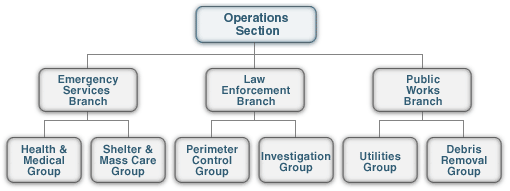
Operations Section: Branches, Other FactorsWhile span of control is a common reason to establish Branches, additional considerations may also indicate the need to use these Branches, including:
Managing the Operations SectionWhile there are any number of ways to organize field responses, Branches and Groups may be used to organize resources and maintain span of control. Operations Section: Expanding and ContractingThe Incident Commander or Operations Section Chief at an incident may work initially with only a few single resources or staff members.

The Operations Section usually develops from the bottom up. The organization will expand to include needed levels of supervision as more and more resources are deployed.
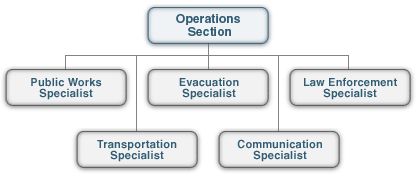
Task Forces are a combination of mixed resources with common communications operating under the direct supervision of a Leader. Task Forces can be versatile combinations of resources and their use is encouraged. The combining of resources into Task Forces allows for several resource elements to be managed under one individual's supervision, thus lessening the span of control of the Supervisor.

Strike Teams are a set number of resources of the same kind and type with common communications operating under the direct supervision of a Strike Team Leader. Strike Teams are highly effective management units. The foreknowledge that all elements have the same capability and the knowledge of how many will be applied allows for better planning, ordering, utilization and management.

Single Resources may be individuals, a piece of equipment and its personnel complement, or a crew or team of individuals with an identified supervisor that can be used at an incident.

As we covered earlier, it is important to maintain an effective span of control. Maintaining span of control can be done easily by grouping resources into Divisions or Groups.
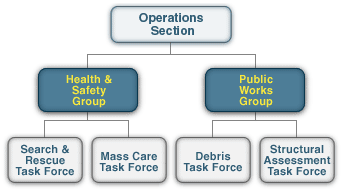
Another way to add supervision levels is to create Branches within the Operations Section.
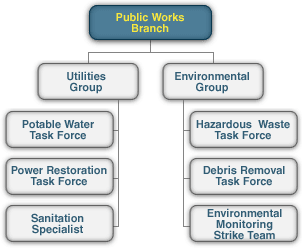
At some point, the Operations Section and the rest of the ICS organization will contract. The decision to contract will be based on the achievement of tactical objectives. Demobilization planning begins upon activation of the first personnel and continues until the ICS organization ceases operation.

Planning SectionThe Incident Commander will determine if there is a need for a Planning Section and designate a Planning Section Chief. If no Planning Section is established, the Incident Commander will perform all planning functions. It is up to the Planning Section Chief to activate any needed additional staffing. Planning Section: Major ActivitiesThe major activities of the Planning Section may include:
Planning Section: UnitsThe Planning Section can be further staffed with four Units. In addition, Technical Specialists who provide special expertise useful in incident management and response may also be assigned to work in the Planning Section. Depending on the needs, Technical Specialists may also be assigned to other Sections in the organization.

Logistics SectionThe Incident Commander will determine if there is a need for a Logistics Section at the incident, and designate an individual to fill the position of the Logistics Section Chief. If no Logistics Section is established, the Incident Commander will perform all logistical functions. The size of the incident, complexity of support needs, and the incident length will determine whether a separate Logistics Section is established. Additional staffing is the responsibility of the Logistics Section Chief. Logistics Section: Major ActivitiesThe Logistics Section is responsible for all of the services and support needs, including:
Logistics Section: Branches and UnitsThe Logistics Section can be further staffed by two Branches and six Units. Not all of the Units may be required; they will be established based on need. The titles of the Units are descriptive of their responsibilities.
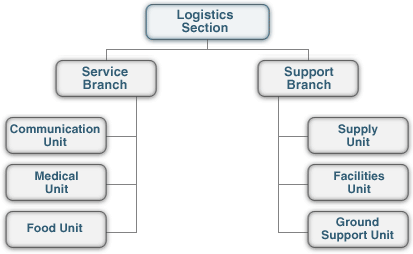
The Logistics Service Branch can be staffed to include a:
Finance/Administration SectionThe Incident Commander will determine if there is a need for a Finance/Administration Section at the incident and designate an individual to fill the position of the Finance/Administration Section Chief. If no Finance/Administration Section is established, the Incident Commander will perform all finance functions. Finance/Administration Section: Major ActivitiesThe Finance/Administration Section is set up for any incident that requires incident-specific financial management. The Finance/Administration Section is responsible for:
Finance/Administration Section: Increasing UseMore and more larger incidents are using a Finance/Administration Section to monitor costs. Smaller incidents may also require certain Finance/Administration support. For example, the Incident Commander may establish one or more Units of the Finance/Administration Section for such things as procuring special equipment, contracting with a vendor, or making cost estimates for alternative response strategies. Finance/Administration Section: UnitsThe Finance/Administration Section may staff four Units. Not all Units may be required; they will be established based on need.

<<< Take the Post-Test—Link to FEMA website >>>
|
| © 2005-2021 Colorado Firecamp, Inc. | home • schedule • blog • ENGB • facility • about us• FAQ's |